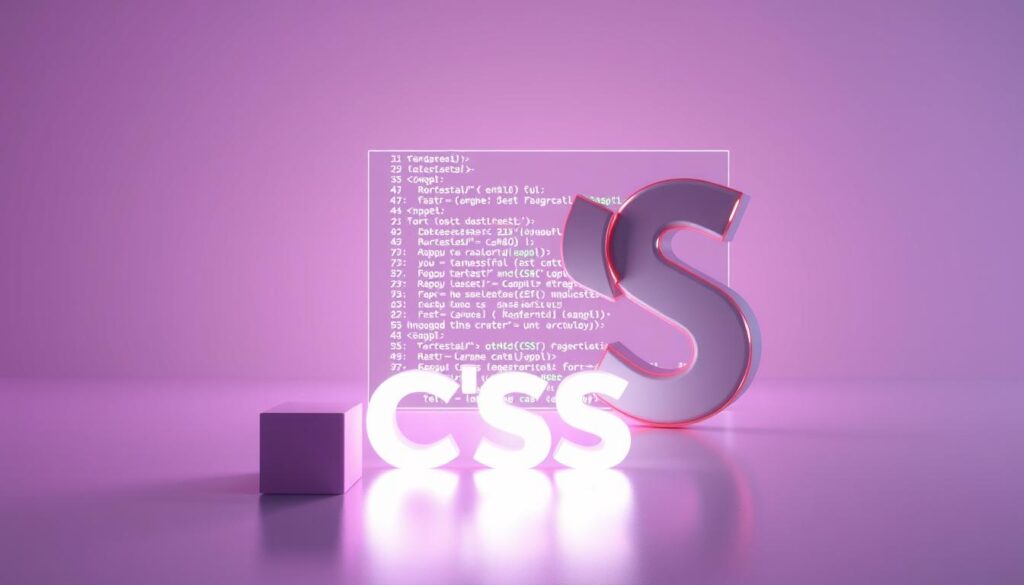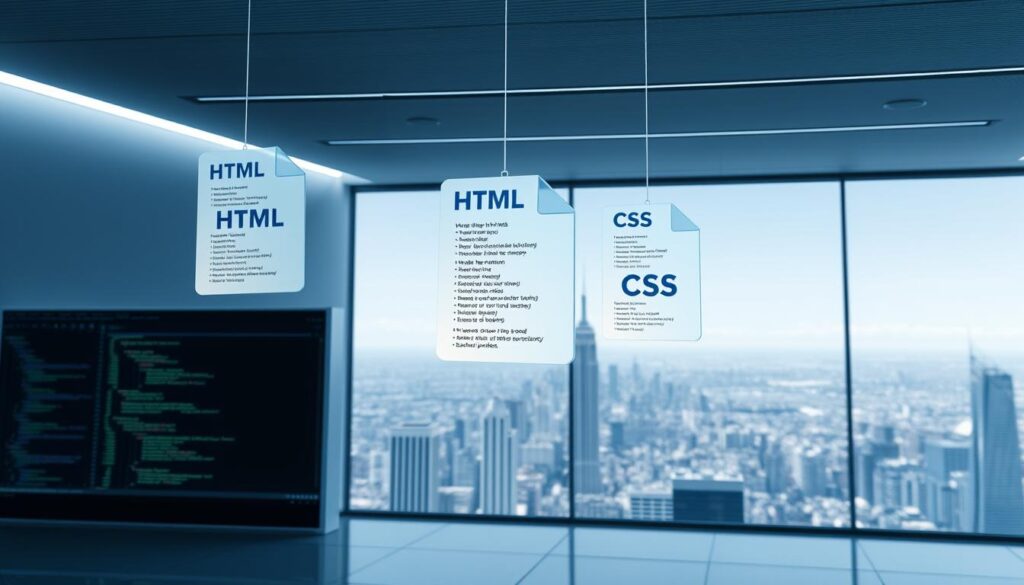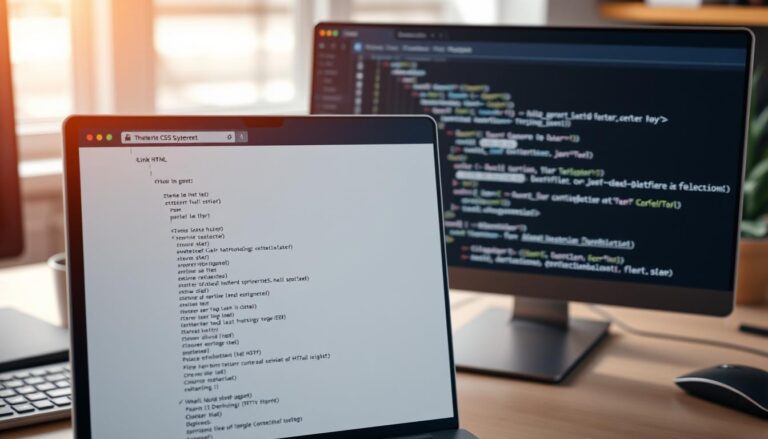Web design needs a smooth mix of HTML and CSS to make websites look great and work well. Knowing how to link CSS to HTML is key for developers at any level. It’s important whether you’re just starting out or have lots of experience.
Styling web pages means linking cascading stylesheets to HTML documents in different ways. You can use external, internal, or inline CSS methods. Each has its own role in web design and development.
Good stylesheet integration helps designers keep content and looks separate. This makes websites more flexible and easier to update. Linking CSS to HTML gives designers control over how a page looks and how it works on different devices.
Key Takeaways
- There are many ways to connect CSS with HTML documents
- Proper CSS linking boosts website design and function
- Stylesheet integration supports responsive web development
- Keeping content and design separate makes code easier to manage
- Knowing how to link CSS is vital for today’s web designers
Understanding the Basics of CSS and HTML Connection
Web development is all about the partnership between HTML and CSS. Together, they form the base of modern web design. Each plays a key role in making digital experiences engaging.

The css html relationship is about structure and look. HTML gives a web page its basic shape and content. CSS, on the other hand, styles and arranges the visuals.
What Makes CSS and HTML Work Together
For HTML and CSS to work well together, you need to understand their roles. Here are the main points:
- HTML builds the page’s structure and content
- CSS takes care of the page’s look and layout
- Stylesheets let developers control design precisely
- They keep content separate from design
The Role of Stylesheets in Web Development
Stylesheets change web design by making visuals consistent and easy to scale. They let designers make changes quickly without touching the HTML.
| HTML Function | CSS Function |
|---|---|
| Content Structure | Visual Styling |
| Define Elements | Define Appearance |
| Semantic Markup | Design Presentation |
Core Concepts of HTML-CSS Integration
Developers use CSS selectors to style specific HTML elements. This method allows for detailed designs with less code.
Three Primary Methods to Link CSS to HTML
Web developers have several ways to link CSS to HTML. Each method has its own strengths and when to use them. Knowing these helps make web designs flexible and efficient.

Let’s dive into each method to help you pick the best for your project.
| Method | Complexity | Recommended Use |
|---|---|---|
| External Stylesheet | Low | Large websites, multiple pages |
| Internal CSS | Medium | Single page styling |
| Inline CSS | High | Specific element customization |
Each way to add CSS to HTML has its own benefits. External stylesheets are great for big sites. Internal CSS is good for small projects. Inline CSS is useful for styling specific elements but can get messy.
Choosing the right method is key. It depends on your project’s needs, like how big it is, how fast it needs to be, and how organized the code should be.
External Stylesheet: The Professional Approach
Web developers often pick external stylesheets for their advanced method of adding CSS to HTML. This method keeps design and content separate. It makes web projects cleaner and easier to handle.
External CSS files bring big benefits for linking CSS with HTML, especially in complex projects. By keeping stylesheets separate, developers can organize code better and work more flexibly.
Benefits of Using External CSS Files
- Improved website performance
- Enhanced code reusability
- Simplified maintenance
- Faster page load times
- Consistent design across multiple pages
File Organization Best Practices
Professional web developers use certain strategies for organizing external CSS files. They keep a logical directory structure. This makes the development process smoother.
| Practice | Description |
|---|---|
| Modular Design | Create separate CSS files for different design components |
| Naming Convention | Use clear, descriptive file names |
| Folder Structure | Organize files in dedicated CSS directories |
Directory Structure Recommendations
- Create a dedicated css folder in your project
- Use subdirectories for complex projects
- Implement consistent file naming
- Separate global and component-specific stylesheets
By using these external stylesheet strategies, developers can make web applications more scalable and easy to maintain. They ensure efficient CSS integration.
Internal CSS: Style Tags in HTML Documents
Internal CSS is a way to mix css with html by adding style rules right in the HTML. It’s great for small web projects or single-page sites. Here, you don’t need to manage many stylesheet files.
Developers put style definitions in <style> tags in the <head> section. This method lets you change how a webpage looks quickly. You don’t need to make separate stylesheet files.
- Ideal for quick styling solutions
- Simplifies small project development
- Reduces external file dependencies
Internal CSS lets developers target HTML elements with selectors. You define rules right in the HTML. This makes styling easier for simple web designs.
Example of internal CSS implementation:
<head>
<style>
body {
background-color: #f4f4f4;
}
h1 {
color: navy;
}
</style>
</head>
Internal CSS is great for small projects but not for big sites. It’s best for quick prototypes or special page designs. For bigger sites, it’s better to use external stylesheets.
Inline CSS: Direct Element Styling
Inline CSS is a special way to style web elements right in the HTML code. It’s used when quick, specific styling is needed without making separate CSS files. Knowing how to use inline styles can help with targeted design solutions.
When to Use Inline Styles
Inline CSS is useful in certain situations:
- Rapid prototyping and testing design changes
- Overriding external stylesheet properties
- Generating dynamic styles through JavaScript
- Creating unique, one-time style modifications
Limitations of Inline CSS
Inline styles are quick fixes but have big downsides:
| Limitation | Impact |
|---|---|
| Reduced Maintainability | Difficult to manage multiple styles |
| Performance Overhead | Increases page load time |
| Code Complexity | Makes HTML less readable |
| Specificity Challenges | Hard to override with external stylesheets |
Developers should use inline CSS carefully. It’s not ideal for big web design projects. External and internal CSS methods are usually better for scalability and maintenance.
Link CSS to HTML: Step-by-Step Implementation
Connecting CSS to HTML is key for web developers. It’s easy when you know the basics. There are many ways to link CSS to HTML, each for different needs.
- Create your CSS file with a .css extension
- Determine your preferred linking method
- Add the right link or style tag to your HTML document
- Check if the connection works
Now, let’s look at the most common ways to link:
External Stylesheet Method
The external stylesheet is best for big projects. You’ll use the <link> tag in the HTML <head> section.
<head>
<link rel="stylesheet" href="styles.css">
</head>
Key Considerations for HTML CSS Linking
| Method | Best Use Case | Performance Impact |
|---|---|---|
| External Stylesheet | Large, complex websites | Minimal, cacheable |
| Internal CSS | Single page applications | Moderate loading time |
| Inline CSS | Specific element styling | Highest performance overhead |
Using the right CSS to HTML linking makes your web pages look great everywhere.
Common Issues When Connecting Stylesheets
Web developers often face challenges when linking CSS to HTML. It can feel like solving a puzzle. Knowing common problems helps fix issues quickly.
Identifying Path Problems
Incorrect file paths are a big reason CSS files don’t link to HTML. Developers must check directory structures and file locations carefully.
- Check absolute vs. relative file paths
- Verify file extension accuracy
- Confirm case sensitivity in file names
Browser Cache Complications
Cached browser data can stop stylesheet updates from showing. Developers need ways to handle browser caching.
| Caching Strategy | Implementation Method |
|---|---|
| Hard Refresh | Ctrl+F5 (Windows) or Cmd+Shift+R (Mac) |
| Disable Cache | Browser Developer Tools |
| Version Appending | Add query string to CSS link |
Syntax Error Resolution
Syntax mistakes can break the link between HTML and CSS. Developers should check their code for errors like missing brackets or wrong selector formatting.
- Validate CSS syntax
- Use browser developer tools
- Check for missing semicolons
- Ensure proper selector syntax
Understanding common challenges helps developers improve their web development. They can make websites more robust and visually consistent.
Multiple Stylesheet Management
Managing multiple CSS files in a web project needs careful planning. When combining CSS with HTML, developers must know how to link two CSS files. This involves organizing files well and understanding how stylesheets work together.
Professional web developers use many stylesheets to keep code clean and organized. Here are some key strategies for managing CSS files:
- Create separate CSS files for different design components
- Use link tags to connect multiple stylesheets
- Understand CSS rule specificity and inheritance
- Implement a logical file naming convention
When linking two CSS files to HTML, the order of link tags is important. CSS rules are applied from top to bottom. This means later stylesheets can change earlier ones. This gives developers control over design elements.
| Stylesheet Type | Use Case | Recommended Practice |
|---|---|---|
| Global Styles | Site-wide design | Load first in HTML |
| Component Styles | Specific page elements | Load after global styles |
| Responsive Styles | Media queries | Load last for proper cascading |
By using these methods, developers can make web designs more maintainable and scalable. They can effectively combine CSS with HTML.
CSS Import Rules and @import Syntax
Web developers look for ways to import CSS into HTML efficiently. The @import rule is a great method. It lets one stylesheet load another directly in your CSS code.
- Using @import within a CSS file
- Embedding @import directly in HTML stylesheet links
Understanding @import Functionality
The @import rule helps manage stylesheets better. It lets developers create separate CSS files. Then, they can import these into a main stylesheet.
Advantages of Using @import
- Improved code organization
- Easier stylesheet maintenance
- Enhanced modularity in design systems
Performance Considerations
While @import is flexible, it can slow down page loading. Browsers download imported stylesheets one after another. This can make pages take longer to load.
It’s best to use @import wisely and explore other ways to load styles for better website speed.
Media Queries and Conditional Stylesheets
Media queries are key in the css html relationship. They help make web designs responsive. They adjust styles based on screen size, resolution, and orientation.
Media queries work by applying different styles under certain conditions. This makes sure websites look good on all devices.
- Screen width breakpoints
- Device orientation detection
- Resolution-specific styling
- Aspect ratio adjustments
To use media queries, developers add the @media rule in CSS. They can target specific device features with ease. For instance:
@media screen and (max-width: 600px) {
.container {
flex-direction: column;
}
}
Responsive design uses media queries for fluid layouts. These layouts adjust well on smartphones, tablets, and desktops. The css html relationship becomes dynamic, making content adapt smartly.
- Define breakpoints strategically
- Use flexible grid systems
- Test across multiple devices
- Optimize performance
Today’s web development needs flexible, responsive designs. Media queries are essential in linking css with html. They help developers create experiences that look great on all devices.
Best Practices for CSS-HTML Integration
Creating seamless html css integration needs careful planning. Professional web developers know that clean stylesheets are key. They help keep web projects scalable and efficient.
Good css link html strategies involve several important points. These can greatly improve code quality and make it easier to maintain.
Code Organization Tips
- Use consistent naming conventions for classes and IDs
- Organize CSS files by component or page section
- Implement a modular CSS architecture
- Leverage CSS preprocessors like Sass or Less
Maintenance Strategies
- Create a systematic file structure
- Use comments to explain complex styling rules
- Implement version control for stylesheet management
| Strategy | Benefits | Implementation Difficulty |
|---|---|---|
| Modular CSS | Improved reusability | Medium |
| Preprocessor Usage | Enhanced code organization | High |
| Consistent Naming | Better readability | Low |
By focusing on clean code principles and strategic stylesheet management, developers can create more maintainable and scalable web projects. These projects can easily adapt to changing design needs.
CSS Preprocessors and HTML Integration
CSS preprocessors have changed how developers work with CSS and HTML. They add advanced features that regular CSS doesn’t have.
Tools like Sass and Less make CSS better with programming-like features. They help developers write stylesheets that are more efficient and easier to keep up with.
- Create reusable variables for consistent styling
- Implement nested selector structures
- Use mixins for complex CSS patterns
- Generate dynamic style calculations
Preprocessors offer many benefits:
| Feature | Benefit |
|---|---|
| Variables | Simplify color and spacing management |
| Nesting | Reduce code repetition |
| Mixins | Create reusable style components |
Preprocessors turn into standard CSS, making it easy to work with HTML. Developers can use these tools to make stylesheets more complex and easier to manage.
Working with preprocessors means writing enhanced CSS files. These are then turned into standard CSS files that link to HTML documents. This method gives developers strong styling options while keeping things compatible with browsers.
Modern CSS Loading Techniques
Web developers are always looking for new ways to link CSS to HTML. They want to make websites load faster and look better. The way we load stylesheets has changed a lot.
Today, web development needs fast ways to add CSS to HTML. This makes websites load quicker and work better for users. Now, developers have smart ways to make stylesheets work smoothly.
Async and Defer Loading Strategies
Async and defer loading are key for better CSS loading:
- Async loading lets stylesheets load on their own, without slowing down the page.
- Defer loading waits until important page content loads before adding CSS.
- Both methods help websites load faster at first.
Performance Optimization Methods
There are advanced ways to make CSS load better:
- Critical CSS extraction – focuses on styles for the top part of the page.
- Lazy loading of stylesheets that aren’t needed right away.
- Reducing the number of things that slow down the page.
| Loading Technique | Performance Impact | User Experience |
|---|---|---|
| Async Loading | Reduced initial load time | Faster perceived page speed |
| Defer Loading | Optimized resource management | Smoother content display |
| Critical CSS | Minimal initial rendering overhead | Instant visual feedback |
Using these modern techniques, developers can make websites load faster. They also keep the CSS code clean and efficient.
Cross-Browser Compatibility Considerations
Developers often face challenges with cross-browser compatibility when linking HTML and CSS. Different browsers interpret CSS and HTML in unique ways. This can cause unexpected design variations.
To ensure consistent styling, developers use several strategies:
- Use vendor prefixes for CSS properties needing special browser support
- Implement feature detection techniques
- Validate CSS files to prevent css file not linking to html issues
- Test stylesheets across multiple browser versions
Managing browser compatibility involves several key strategies:
- Utilize CSS reset stylesheets to normalize default browser styles
- Implement responsive design principles
- Use modern CSS frameworks with built-in cross-browser compatibility
When fixing css file not linking to html problems, developers should check:
- Correct file path references
- Proper syntax in link tags
- Browser developer tools for potential errors
Modern web development tools like Autoprefixer and CSS validation services help a lot. They make creating cross-browser compatible stylesheets easier. This reduces potential rendering inconsistencies.
Conclusion
Web development needs a deep understanding of linking CSS to HTML. This guide shows many ways to do this, from using external stylesheets to inline methods. Each method has its own benefits for making web pages look great and work well.
Knowing how to link CSS ID to HTML is key for targeted styling. Developers can choose from external, internal, or inline CSS based on their project needs. The goal is to pick the best method for performance, ease of use, and design flexibility.
Modern web development requires careful stylesheet integration. By following the best practices in this article, developers can make stylesheets that are clean, organized, and grow with the site. Keeping up with new CSS methods and practicing these techniques will help web professionals build better websites.
As web technologies change, it’s important to stay current with CSS integration. By practicing, trying new things, and understanding how stylesheets work, developers can make web pages that are both dynamic and visually appealing. This meets today’s design standards.
